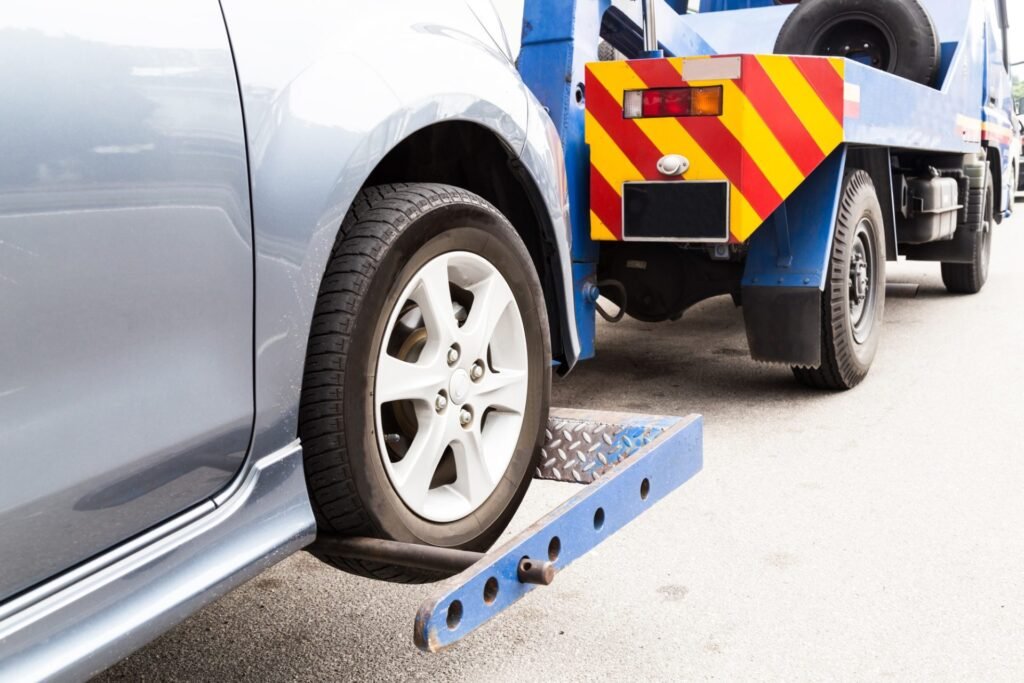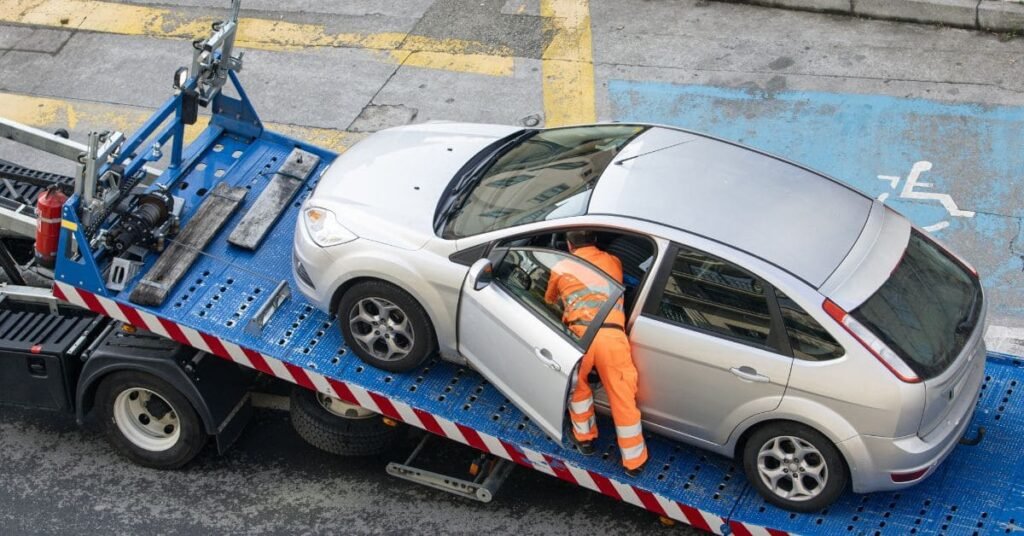Sure! Here’s your paragraph with the word “Ontario” included:
A tow dolly is a light-frame trailer that cradles the front wheels of the car being towed, leaving the rear tires on the pavement. That lifting arrangement lets you transport an operable or inoperable car without the wear a long highway haul puts on its powertrain, and it gives a tighter turning circle than a full trailer. For seaside road trips in Ontario, seasonal RV hauls, or emergency service yards that lack big-rig trailers, dollies provide a midway solution between towing by rope and the heft of a flatbed truck.
A tow dolly lifts only the front wheels of the vehicle being towed, leaving the rear wheels on the ground. Because of this partial lift, tow dollies weigh less, cost less, and usually take up less space than full flatbeds.
Table of Contents
ToggleWhen Should You Choose a Dolly Rather Than a Bigger System?
Deciding which towing device to buy, rent, or borrow depends on your needs, your budget, and the kind of trips you plan.
Value for Money
Two dollies are cheaper than flatbed rigs, and that savings matter if you are moving a car a few miles rather than across the country.
Simple Loading
Sliding a car onto a dolly often takes less skill and fewer tools than hoisting it onto a full trailer, so friends, family, or small crews can help.
Best for Front-Wheel Drive
Since the front wheels are pinned to the dolly and the rear wheels roll freely, the system spares the transmission and avoids damage that long-distance towing might cause.
Portable and Lightweight
A tow dolly weighs far less and takes up much less garage space than a full tow truck, so owners find it easy to tilt, slide, or store behind a car when the job is done.
Minimal Maintenance
Because the dolly has no hydraulics, power jack, or engine, its workday moving parts are few, and routine tasks—lubing wheel bearings, looking at wires, and checking tire pressure—are both quick and rare.
How Does a Tow Dolly Work?
Using a tow dolly is almost plug-and-play. The towing vehicle—a large SUV, half-ton pickup, or restored classic—hitches to the dolly’s coupling pin, and the driver either rolls or gently winches the towed vehicle front-end onto the dolly ramp. The rig’s diamond-shaped cradle lifts only that front pair of tires, leaving the rear wheels free on the pavement.
Once the wheel straps bite and the safety chains are clipped, the dolly is ready to go. With rear tires running naturally, the towed car tracks straight and brakes normally, allowing a quiet freeway cruise or brisk stoplight dash through town.
Tow Dolly vs. Flatbed Tow Truck: Which One to Choose?
When university staff find themselves needing to tow a car, they usually face a simple question: platform or dolly? The answer turns on the vehicle being moved, the budget for the job, and the tow site itself. The summary that follows highlights the strong and weak points of each option.
Tow Dolly Engineered for Front-Wheel Drive Cars
A tow dolly lifts the front wheels off the pavement, freeing the steering and leaving the rear wheels to roll legally and safely. That setup works fine for most commuter cars on campus.
Money-Saving Tool
Rental rates for a dolly usually come in well below what rental companies ask for a full truck with deck and ramps.
Light and Compact
Because a dolly weighs less than a small hatchback, a staff member can slide it into a side lot and forget about it until the next call for help.
Drivetrain Risk for Four-Wheel Drives
All-wheel and true four-wheel-drive models still stress many components when dragged by the rear. In those cases, hitching all the wheels to a flatbed is the safer call.
Flatbed Tow Truck Universal Compatibility
From restored vintage rally cars to broken-down shuttles, a flatbed can swallow practically every shape and stance on the lot without second-guessing the drivetrain.
Higher Price Tag
The hydraulic gear, steel frame, and larger towing rating baked into a flatbed mean rental firms charge a premium, especially after-hours or during move days.
Full Vehicle Raised
Because a flatbed truck raises the entire vehicle off the pavement, it spares the drivetrain from stress and keeps fragile components safe during transport.
Both options work well, yet if you’ve got a front-wheel-drive car and need to move it a few blocks on a budget, a tow dolly still makes good sense.
Picking the Right Towing Service for Your Dolly
So you want to rent a tow dolly [doh-lee], yet how do you steer toward a towing outfit that actually knows how to use one? The reassuring part is that most roadside firms stock both dollies and full rollback rigs.
Here are practical steps for matching the right crew to your job:
Search for Listings Nearby
The simplest start is typing towing near me into your phone. That search will pull up a map of local shops that move cars, along with the array of rigs—wheels-on-the-ground, wheels-up, and everything in between.
Verify Availability
Before hiring a tow dolly, confirm that the company has a truck and driver available when you need them. If your car fails in the middle of a trip, a provider with a fast-release schedule will get you moving again sooner.
Request Estimates
Always ask for a written estimate before giving the green light. Rates vary based on distance, vehicle size, and whether fees for loading, unloading, or after-hours service apply.
Check Ratings
Scan online ratings or get word-of-mouth referrals from friends. A solid firm keeps its promises and leaves a trail of positive reviews from relieved customers.
Standard Applications for a Tow Dolly
A tow dolly is a low-cost, lightweight trailer that carries a vehicle’s front wheels while following behind the tow rig. Here are several typical tasks for which drivers rent or buy one:
Roadside Rescue
When a car dies miles from home, a tow dolly lifts the front tires and tows the rest safely. Auto clubs often cover the move, letting members avoid roadside storage fees.
Moving Vehicles
If you need to get a car from point A to point B, a tow dolly simplifies the task. The dolly shines on long trips when driving the car yourself would be impractical or impossible.
RV and Trailer Towing
RV owners often bring a runabout along for errands, and a tow dolly makes that hitch-up quick.
Non-Running Vehicles
If a car won’t start or is overdue for repair, a dolly provides a gentle lift, protecting fragile parts while the load rolls to the shop.
Two Dolly Safety Tips
When hitching and hauling, safety is not optional. Stick to these quick checks and habits, and the trip will stay trouble-free.
Ensure Proper Loading
Before you pull out, walk around and confirm the towed car’s front wheels sit squarely on the dolly and every strap, chain, and ratchet clicks tight.
Follow Weight Limits
Review the dolly’s manual and weigh the car if you have doubts. Exceeding the limit can fry brakes, squat hitch height, or snap tires way earlier than expected.
Check Tire Compatibility
Before attaching the dolly, inspect the towed vehicle’s tires to ensure they fall within the dolly’s rated size range. Most models work well with standard passenger-car tires, yet manufacturers’ instructions only guarantee a secure fit.
Drive Cautiously
Adding dozens of extra pounds will change how your vehicle accelerates, stops, and corners. Slow down, leave more space before traffic signals, and rehearse wider, gentler turns; those habits will help prevent skids and trailer sway.
Use Caution on Hills
Steep grades push brakes and engines harder still. Whenever possible, park the rig on a moderate slope, hitch it there, and check that brake heat will not catch you by surprise halfway down.
Conclusion
Tow dollies offer a practical and efficient solution for transporting vehicles, especially in areas like Ontario, where road trips and seasonal RV hauls are common. Whether you’re dealing with an operable or inoperable car, a tow dolly minimizes wear on the powertrain and provides maneuverability that a full trailer may not offer. It’s the ideal midway option for emergency service yards and personal travel, striking the perfect balance between ease of use and cost-effectiveness.
Frequently Asked Questions
What Is the Difference Between a Tow Dolly and a Flatbed Tow Truck?
A tow dolly lifts the front wheels only, letting the rear tires roll; that design works well with front-drive cars. A flatbed truck raises the entire vehicle, so it can carry all-drive machines without spinning any wheel.
Is a Tow Dolly Safe for Long-Distance Towing?
Yes, a tow dolly is generally regarded as safe for long trips, particularly when towing a front-wheel-drive car. To maximize safety, make certain the vehicle is properly strapped down and that the combined weight does not exceed the dolly’s published limit.
Can I Tow a Rear-Wheel-Drive Vehicle with a Tow Dolly?
Towing a rear-wheel-drive car on a dolly is not advisable because the rear wheels remain on the ground and may spin while the driveshaft is still engaged, risking serious damage. For that type of vehicle, and most all-wheel drives full flatbed trailer is the safer option.
How Much Does It Cost to Rent a Tow Dolly?
Rental rates fluctuate based on geography, retailer, and the length of time the dolly is needed, but typical fees fall in the 30-to-50-dollar-per-day range; supplemental mileage or damage waivers may add to the final bill.


 Call us at
Call us at  Email us at
Email us at 
